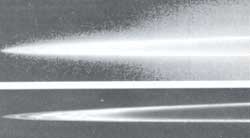Rings of mystery
 WAGES from the Galileo spacecraft show conclusively that the three faint rings around Jupiter come from moon dust spiralling down into the planet's atmosphere.
WAGES from the Galileo spacecraft show conclusively that the three faint rings around Jupiter come from moon dust spiralling down into the planet's atmosphere.
No one knew that the rings existed until the Voyager spaceprobe few by the planet in 1979. The dusty rings are visible only when light hits on them at certain angles, much like dust in our own homes that reflect light slanting through a window. This was one reason why scientists had a hard time photographing these rings.
The latest batch of photos, released recently at a press conference at New York's t]ornell University are some of the best yet, and finally clear up the mystery of how the rings were formed. The press conference was sponsored by the us National Aeronautics and Space Administration (NASA).
Unlike the icy, snowball-sized chunks that comprise Saturn's rings, the dust particles surrounding Jupiter are so small that the mere act of reflecting light gradually slows their orbit, and after 1,000 to 10,000 years, they drop in to the planet's atmosphere. Scientists knew that something was replacing the particles thus lost. Their prime suspects were the micrometeors, which, they said, were knocking (lust off Jupiter's four small innermost moons, as the rings lay very close to (lie lunar orbits.
The Galileo images, coupled with pictures taken from the 10-m telescope in Keck Hawaii in 1997 when Earth lay in the plane of the rings, firmly link the moons to the rings. Most impressive were the new snaps of the outermost and the faintest ring, which was photographed in 1985. Galileo's photos show that this 'gossamer' ring contains two cloudy lobes of varying thickness that resemble the dust p)umes coming down from Amalthea and Thebe, the outermost of the four inner moons (New Scientist, Vol 159, No 2152).
The moons orbit at the outer edge of each cloudy lobe, and the shape and thickness of the lobes match what would be expected if dust is moving from the slightly tilted moons towards Jupiter's equator, "The story looks a lot more convincing now with the gossamer ring," says Phi) Nicholson, a Cornell astronomer who was on the team that worked on the Keck images.
Jupiter's inner and denser ring has been linked to the innermost safeliftes, Adrastea and Metis. The photos show that most of the material comes from Adrastea, the smallest of the inner moons. It produces the most dust as it has the weakest gravity and debris can escape more easily.
"The Galileo data are just terrific in showing that the phenomenon is creating dusty rings," says Larry Esposito, astronomer at the University of Colorado in Boulder, USA. Esposito has been studying planetary rings for over a decade. The process that 'built' Jupiter's rings may also explain the rings seen around Neptune, Nicholsen speculates. It, however, could not have generated the narrow rings of Uranus, which are denser and made of dark particles which can measure a centimetre in diameter, or the bright, icy rings of Saturn.
Composition of the dust and the inner Jovian satellites remains a mystery, although scientists say their colour suggests that part of it might be pollution from volcanoes on the large moon called lo.
